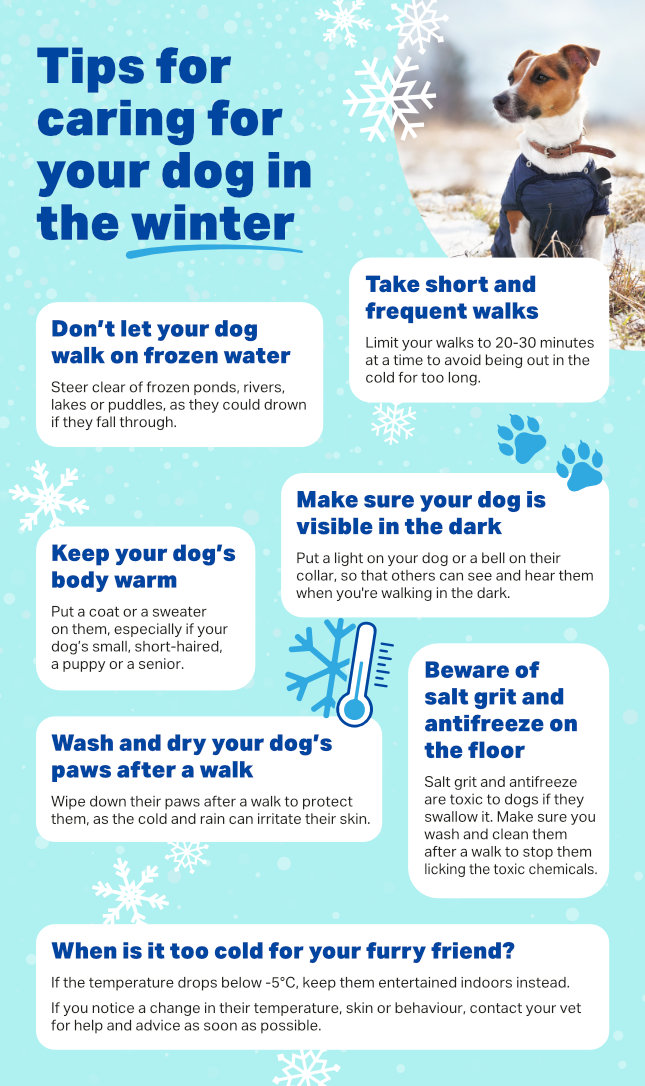
When the weather gets colder, you’ll want to do all that you can to make sure your dog is safe and warm during the winter months.
Follow our tips for caring for your dog and keeping them safe in the winter.
How can you tell if your dog is cold?
Just like humans, dogs can feel the cold too - especially if they don’t have a big furry coat to keep them warm.
There are a few signs to look out for that tell you your dog is too cold. These are:
- shivering
- moving slowly or limping
- barking or whining
- curling up to try and keep themselves warm
- shaking
- hunched posture
- tucked tail
- changes in behaviour (anxious or unsettled)
- seeks places for shelter/warmth
- holds paws off the cold ground
How frostbite and hypothermia might affect your dog
Cold and wet weather can cause hypothermia in dogs, so it’s important that you keep them warm during the winter.
Hypothermia is when the dog’s body temperature drops dangerously below their average temperature, which is between 37.7 - 39°C.
Some signs of dog hypothermia are:
- shivering
- drowsiness or lethargy
- Confusion
- pale gums
- muscle stiffness
Elderly dogs, puppies, small dogs and dogs who have short or thin coats or are unused to cold temperatures, are at higher risk of developing hypothermia. All these factors, especially in combination, make it harder for dogs to keep themselves warm when the temperature drops.
As hypothermia worsens, dogs will:
- stop shivering
- collapse
- have fixed and dilated pupils
- develop slow and irregular heart and breathing rates
- become unconscious
- potentially die
What to do if you think your dog has hypothermia
If you think your dog is suffering from hypothermia, follow these steps:
- Get your dog into a warm building or vehicle.
- Wrap them in blankets, towels, coats, etc. If you can, warm up some blankets on a radiator, in a clothes dryer, or using a hairdryer – but be careful they don’t burn!
- Place bottles of warm water next to your dog, but always keep a couple layers of fabric between the bottle and your dog’s skin.
- Get medical attention from a vet immediately.
Dogs can also suffer from frostbite if they’re out in the cold for too long. Frostbite is damage caused to skin and other tissues due to extreme cold. When the environmental temperature drops below 0°C, blood vessels close to the skin start to narrow or tighten.
This is when their skin freezes and turns a pale bluey grey shade. It's most likely to happen in body parts farthest from the heart and in tissues with a lot of exposed surface area.
Their skin can swell and they may develop blisters on their skin and paws, which can be very painful and cause them to limp.
If you think your dog has frostbite, go and see a vet immediately and try to keep them warm until they’re seen.
What temperature is too cold to walk a dog?
You shouldn’t walk your dog in temperatures below freezing, which is usually below -5°C.
How different dogs cope with the cold weather can depend on their body weight and coat.
Large dog breeds with longer coats will be able to withstand the cold more than small, short-haired dog breeds.
Generally, if it’s too cold for you to go on a walk then it’s probably too cold for your dog too.
How to keep your dog warm at night
An easy way to keep your dog warm at night is to make sure your dog has plenty of blankets and warm bedding, and that the room they sleep in is warm.
If the room has a draft, get a draft excluder or move them away from the door or windows.
Top tips for winter walks
Keep your dog warm and safe on wintery walks by following these helpful tips:
- Take shorter and more frequent walks so your dog isn’t out in the cold for too long. 20–30-minute walks are better than long hikes.
- Keep their body warm by putting a dog-suitable coat on them. Small and short-haired dogs can wear a sweater or a coat to keep them warm on their walks.
- Make sure your dog is visible if you’re walking them in the dark by attaching a light to their collar, lead or jacket. They should wear a collar and by law, an ID tag that’s microchipped at all times when they’re walking, regardless of the weather.
- Don’t let your dog walk on frozen ponds and puddles as they could fall through.

Protect your dog’s paws
Snow and ice can harm your dog’s paws and irritate their skin, so it’s important to look after them.
Check your dog’s paws after walking them to make sure they’re clean. Wash and dry them, especially if there’s grit salt on the roads as this is toxic and can harm their paws.


